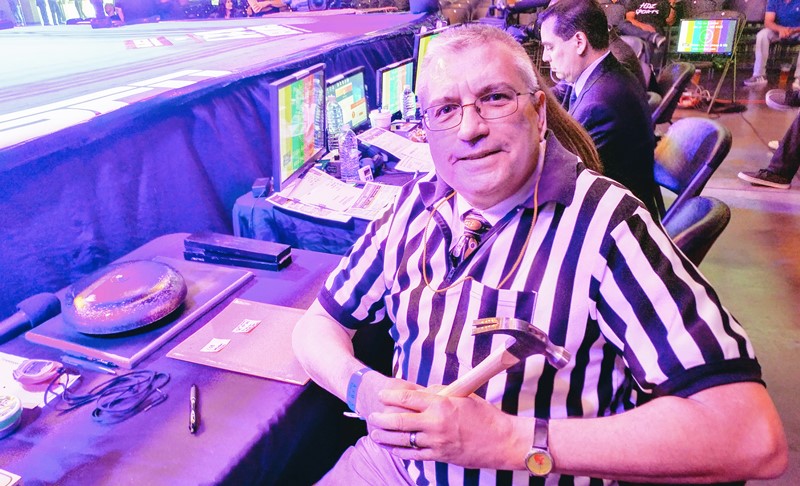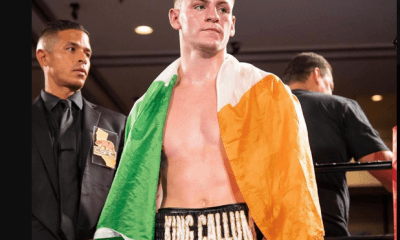Featured Articles
The Avila Perspective Chap. 18: Timekeepers, Pension and Coming Fights

Mike North works in the underbelly of the boxing world in a state that sees more fight business in a month than other states see in an entire year.
If this was the military, he might be a radar technician or man the sonar in a nuclear-powered submarine.
But this is prizefighting, and in his role, North tirelessly works with a stopwatch as the official timekeeper. It’s a role that he’s performed for hundreds of fights through two decades in the state of California.
North will be inducted into the California Boxing Hall of Fame for his many years spent as an official timekeeper for the California State Athletic Commission. The ceremony takes place on Saturday Oct. 20, at the Sportsman’s Lodge in the Studio City area of Los Angeles.
Others being inducted are Michael Carbajal, Chango Carmona, Frankie Liles, Guty Espadas Sr. and Guty Espadas Jr., Jose Celaya and others.
As a youngster in Kansas City, Missouri who loved boxing, North began as an amateur boxer and frequented the nearby gym to learn the fistic art.
“The people training me said you’re not very good, why don’t you be a writer or photographer. So, I became one in 1990,” said North, adding that he moved to California and began working first as a photographer and then as a writer for various sports publications, including a magazine called Ring Sports.
Through his work as a journalist, he began meeting ring officials and was persuaded to apply for a position as a boxing official for the state of California.
“I got to meet a lot of officials, and Dick Young was a Missouri boy like me. He recommended to me to be an official in 1998,” said North who, because of an abundance of referees and judges, opted for the role as a timekeeper.
He’s been working the fights as a CSAC timekeeper ever since.
“One of my first shows on TV was for Julio Cesar Chavez at Staples Center. That was one of my first shows. I was happy to do that show. The boxing legend and his son made his pro debut but he (senior) got beat up and later retired. So, I got to time his second to last fight,” said North of the fight that took place in May 2005.
Along the way, North has worked many of the biggest prize fights in Southern California, including the Oscar De La Hoya and Steve Forbes fight at the StubHub Center in May 2008. That fight drew more than 30,000 fans into the stadium where the LA Galaxy and LA Chargers now play.
Another memorable moment for North occurred with one of his favorite fighters, Bernard Hopkins in 2016. That title contest turned out to be the Philadelphia fighter’s final prize fight.
“I was timekeeper when Bernard Hopkins got knocked out of the ring,” said North, who is married and works about 30 fight cards a year. “That night during a championship fight, he gets knocked out of the ring. He’s got 20 seconds to get back into the ring. I start counting. One or two of the inspectors helped him out. Once they touched Hopkins the fight was over and I finished counting.”
That fight emphasizes just one of the many duties of a timekeeper. Once any fight card begins, a timekeeper has to manage the clock, bell and whistle for the ring announcers, referees, and television when it’s involved.
It’s a tedious adventure and not meant for everyone.
“The difficulties come in doing it when I’m tired. Talk about the fundamentals, the hardest thing is having to stay focused during the entire fight from beginning to end. In a big 12 round fight, it’s 50 minutes just timekeeping and focusing, maintaining discipline of timing the rounds and rests and counting the knockdowns. Those are the biggest demands for a timekeeper,” said North, who works as an aerospace engineer during the day.
“It’s not as easy as people think. Especially if you are doing live TV like HBO, there are all kinds of distractions. Sometimes when you are on live TV it adds a little bit of pressure to you.”
Experiencing that pressure and dealing with it over the last two decades has prompted California State Athletic Commission executives to appoint North as an advisor for new recruits joining the ranks of timekeepers.
The first advice he gives is purchasing a reliable stopwatch, whistle, bell and black and white striped shirt.
“I recommend they buy a stopwatch that has a certificate of calibration from a manufacturer and costs over $25. You need to have two to four stopwatches in case one goes out,” says North, who has more than one of everything.
“Once, I had a whistle with a corked ball inside of it. I was doing a fight at the Playboy Mansion and the corked ball blew out the gap of the whistle. It didn’t impact the fight. But a malfunction can impact the fight if you are not prepared.”
North is always prepared.
“It is difficult to find people that want to do timekeeping, stay with it and like to do it,” said Andy Foster, Executive Director for CSAC. “We don’t have that many. It’s a real skill to picking up that count, to working with the referee and having the focus and instincts. There is a real skill to it.”
After 20 years of working along the boxing rings throughout Southern California, the veteran timekeeper realizes a need for more official clock watchers has arrived. But his time is not over as he works with new recruits.
“It has a lot of rewards that go with it. We have the best seats in the world for boxing events,” said North, who also keeps time for MMA bouts. “It’s very rewarding because you get to meet a lot of great people.”
Many of those people will be at the Sportsman’s Lodge when North receives his entry into the California Boxing Hall of Fame.
Time really does go fast when you are having fun.
California Pension for boxers
“A pension fund established for retired boxers has reached a total of more than $5 million dollars,” said Andy Foster, Executive Director for CSAC.
Any retired boxer over the age of 50 who fought more than 75 rounds with no more than a three-year break, or 10 rounds a year for at least four years without a three-year break is eligible for money due.
The pension fund was established in 1982 to help retired prizefighters in their older years.
A list will be provided soon and a future story on this will also be available.
Downtown L.A. and Indio on Thursday night
In the old business district of downtown Los Angeles, a boxing show takes place at the Exchange LA, located at 618 S. Spring Street, L.A. 90014. PR Sports is putting on the show that features Gloferson Ortizo, Adan Ochoa, and Damien Lopez among others. A couple of years ago it’s where current budding prospect Ryan “The Flash” Garcia made his first American debut as a professional.
It’s a solid fight card.
Doors open at 6:30 p.m. For more information call (310) 315-0525.
It can be seen on the CBS Sports website.
About 120 miles east another boxing card takes place.
Fantasy Springs Casino hosts a Golden Boy Promotions fight card showcasing Ireland’s Jason Quigley (14-0) against Mexico’s Freddy Hernandez (34-9) in a middleweight clash set for 10 rounds.
Quigley defends the NABF title he won in March 2017. During that fight against Glen Tapia he broke his hand and was out of action for a year. He returned this past March and won by knockout on a Massachusetts card.
Hernandez, 39, is a veteran originally from Mexico City who fights out of L.A. His best victory came against Alfredo Angulo two years ago. He’s crafty and doesn’t take chances.
ESPN2 will televise the Golden Boy card.
Friday in Ontario
Thompson Boxing Promotions rolls out another boxing card at the Doubletree Hotel in Ontario. Doors open at 6:30 p.m.
For 18 years this Southern California promotion group has been uncovering hidden jewels. Its latest is WBA super bantamweight champion Danny Roman, who is expected to be present at the fight card this Friday, Oct. 19.
Roman will be introduced to the crowd. Last week, the Los Angeles-based prizefighter knocked out England’s Gavin McDonnell in the 10th round in Chicago. It was his third successful defense of the title he grabbed in Japan a year ago.
A primary reason I’ve covered these fight cards has been Thompson Boxing’s ability to discover talent like Roman and many others.
Saturday in Las Vegas
WBA middleweight titlists Ryota Murata (14-1, 11 KOs) defends the title against Rob Brant (23-1, 16 KOs) in a 12 round clash on Saturday Oct. 20, at the Park Theater MGM in Las Vegas. The Top Rank card will be televised by ESPN.
Murata, 32, doesn’t have time to waste at his age. He needs to go after the big guns, whoever they are. As the holder of the minor version of the title, he’s got to keep his place in line. And like most Japanese fighters, he’s not shy about taking chances.
Brant, 28, will be fighting an upper tier opponent for the second time. His only loss was to former WBA and WBO world light heavyweight champion Juergen Braehmer in first round action in the World Boxing Super Series 168-pound tournament.
With Canelo now holding the WBC title and fighting for the WBA super middleweight title in December after defeating Gennady Golovkin by decision, the middleweight division is wide open.
In the semi-main event, a super lightweight match set for 10 rounds, Russia’s Maxim Dadashev (11-0,10 KOs) meets the ultimate gatekeeper in Mexico’s Antonio DeMarco (33-6-1, 24 KOs).
Dadashev, 28, has knocked out almost all of his opponents, so the brain trust at Top Rank wants to see if he can truly fight someone who does not go down easily.
DeMarco, 32, is a rangy former world titlist from Tijuana who has warred against the best punchers in the business, including wins over Jorge Linares, John Molina and Mickey Roman. He doesn’t quit. He didn’t quit against one of the best punchers of all time, Edwin Valero, in that fighter’s last pro fight.
It’s a perfect test for Dadashev. It’s also a good fight for DeMarco to prove that he deserves another world title shot.
Check out more boxing news on video at The Boxing Channel
-

 Featured Articles4 weeks ago
Featured Articles4 weeks agoVito Mielnicki Jr Whitewashes Kamil Gardzielik Before the Home Folks in Newark
-

 Featured Articles7 days ago
Featured Articles7 days agoResults and Recaps from New York Where Taylor Edged Serrano Once Again
-

 Featured Articles6 days ago
Featured Articles6 days agoResults and Recaps from NYC where Hamzah Sheeraz was Spectacular
-

 Featured Articles2 weeks ago
Featured Articles2 weeks agoFrom a Sympathetic Figure to a Pariah: The Travails of Julio Cesar Chavez Jr
-

 Featured Articles2 weeks ago
Featured Articles2 weeks agoCatterall vs Eubank Ends Prematurely; Catterall Wins a Technical Decision
-

 Featured Articles1 week ago
Featured Articles1 week agoPhiladelphia Welterweight Gil Turner, a Phenom, Now Rests in an Unmarked Grave
-

 Featured Articles4 weeks ago
Featured Articles4 weeks agoMore Medals for Hawaii’s Patricio Family at the USA Boxing Summer Festival
-

 Featured Articles4 weeks ago
Featured Articles4 weeks agoCallum Walsh, Umar Dzambekov and Cain Sandoval Remain Unbeaten at Santa Ynez












